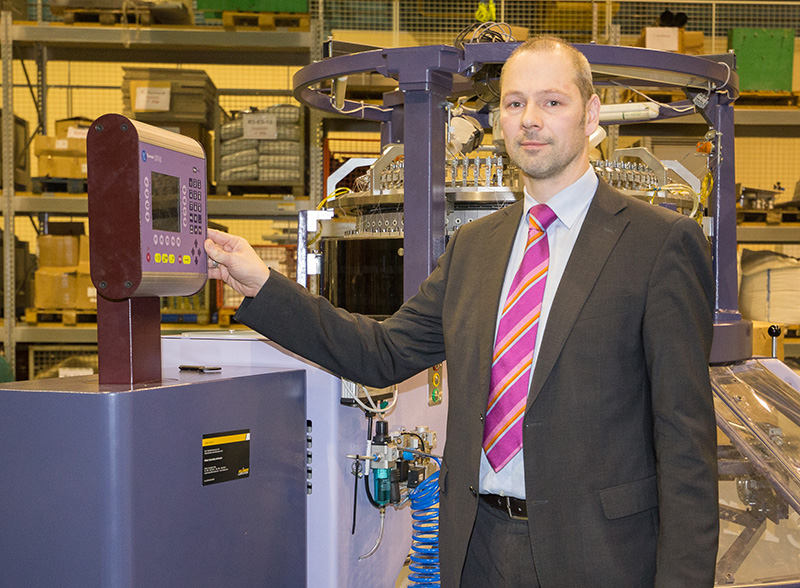From fiber production to the finished product
Eleven questions for Prof. Dr. Holger Cebulla, Professor of Textile Technologies since May 2014
-

"By reviving the oldest textile professorship of Germany, we supplement the higher education landscape by the textile expertise, which is now required in many disciplines" - this is how Prof. Dr. Holger Cebulla explains the significance of his Professorship of Textile Technologies. Photo: Steve Conrad
Prof. Dr. Holger Cebulla (42) holds the Professorship of Textile Technologies at the Faculty of Mechanical Engineering since May 2014. In eleven answers he gives the readers of “University News“ an insight into his career, goals and his time in Chemnitz.
What do we actually understand under “textile technologies“?
The textile technologies contain everything that has to do with textile materials or methods, that is, from fiber production to the finished product. The spectrum of materials ranges from natural fibers such as cotton to metals and up to high-tech materials like ceramic or carbon. The final products can be classic clothing, medical devices, and especially high performance textiles for concrete, metal or plastic composites. Another component of textile technologies are the machines for the production of textiles.
TU Chemnitz is for me as a professor the right choice, because...
…it offers the best existing working environment for a textile researcher. The professorship is located at the biggest Institute for Lightweight Structures in Germany and is responsible there for the production of reinforcing structures. Furthermore, the Institute is home for the Professorship of Sports Engineering, which in turn uses the high performance textile materials in the sports equipment. This environment is complemented by two textile institutes in Chemnitz – Cetex and STFI. Summing up, the manpower in numbers, these are more than 400 scientists dealing with textile and lightweight issues – a uniqueness in Europe.
Could you say a few words about your academic career?
I studied Mechanical Engineering and Textile Technology in Heidenheim and Dresden. I wrote my PhD at TU Dresden with two experts – Prof. Peter Offermann and Prof. Karl-Heinz Modler. This work has also received the Innovations Prize TechTextil and the Prize of the German Textile Machinery Association (VDMA) for dissertations. During this period emerged 30 publications. Then followed more than ten years of global industrial activities in various management positions.
Describe your study time in about 15 words.
Learning, lack of sleep, global conferences, parties, Catholic student community, flood of the century, the philharmonic hall, Semperoper, art museums, banks of river Elbe.
Did you have role models during your studies who encouraged you to pursue a scientific career?
I had four very good professors who inspired me, encouraged, educated and challenged.
What advice would you give young students and graduates?
To take advantage of the infinite possibilities of the university, to look beyond their own noses and so acquire a range of skills. Whether in other courses of study, in the cafeteria, the student life outside university, or in the world travel with a backpack.
What would you like to achieve in the teaching for the future?
That for every student, who studies Mechanical Engineering, it goes without saying to attend the lecture in Textile and have textile know-how.
Which impact do you make in the research at TU Chemnitz?
By reviving the oldest textile professorship of Germany (closed from 1995 until 2014) at the University, we supplement the higher education landscape by the textile expertise, which is now required in many disciplines. Our focus is on the development of new highly productive textile process for fiber plastic composites that meet the requirements from industry.
There are around 45,000 professors at German universities. What sets you apart from others?
Nothing - I hope that each of these 45,000 professors is a specialist in her/his field and has the motivation, to bring research forward and to pass on the knowledge to the students.
Which place do you show your guests the most in Chemnitz?
The Villa Esche from the year 1903, designed by star architect Henry van de Velde. It represents for me the link between textiles of the past of the Saxony’s Manchester-Chemnitz and today, as well as the link between industry and art. Nowadays, it should be strengthened again.
How do you play a part in the life of the city?
I try to sensitize people that they do not live in some city, but in the textile capital of Europe. Around the year 1910, Chemnitz was the second richest city in Germany thanks to the textile industry and in consequence of the mechanical engineering.
Further information about the professorship at: https://www.tu-chemnitz.de/mb/tt/
(Translation: Nataliia Boiko)
Katharina Thehos
12.02.2015





